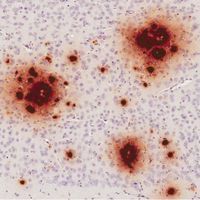Login
Subscribehuman research, neuroscience

A Microbial Link to Parkinson’s Disease
Mariella Bodemeier Loayza Careaga, PhD | Dec 4, 2023 | 6 min read
Haydeh Payami helped uncover the genetic basis of Parkinson’s disease. Now, she hopes to find new ways to treat the disease by studying the gut microbiome.

Neurological Correlates Allow Us to Predict Human Behavior
Paul J. Zak | Oct 1, 2020 | 10+ min read
A combination of factors, from oxytocin release as an indicator of emotional investment to cortisol and other hormones that correlate with attention, can forecast what people will do after an experience.

Increased Neuronal Activity Shortens Lifespan in Animals
Ruth Williams | Oct 16, 2019 | 3 min read
Suppressing the natural age-related increase in neuronal excitation lengthens the lives of worms, and there are indications that the same may be true for mice and humans.

Brain Rhythms Guide How Humans Pay Attention
Phil Jaekl | Dec 1, 2018 | 4 min read
A perception of sustained focus may actually be the result of cycles of fluctuating rather than continuous neural activity, according to new behavioral and neurological data from studies in humans and macaques.

Both Sides of the Brain Are Active During One-Sided Arm Movement
Anna Azvolinsky | Oct 8, 2018 | 4 min read
Researchers directly recorded neural activity in both sides of the brain’s cortex during the movement of only one arm in humans.

Image of the Day: Hide and Seek
Sukanya Charuchandra | Jun 26, 2018 | 1 min read
Neurons of the embryonic subplate don’t die as scientists had thought.

Herpes Viruses Implicated in Alzheimer’s Disease
Anna Azvolinsky | Jun 21, 2018 | 5 min read
A new study shows that the brains of Alzheimer’s disease patients have a greater viral load, while another study in mice shows infection leads to amyloid-β build up.

Retrieving Short-Term Memories
Anna Azvolinsky | Dec 1, 2016 | 3 min read
Neurons can continue to capture a short-term memory without continuous firing, researchers show.

Nascent Neurons Journey Through Newborn Brain
Anna Azvolinsky | Oct 6, 2016 | 4 min read
Young cells make their way to the frontal lobe to create new circuits in the brains of infants, researchers report.

Specialized Neurons Encode Social Learning in Humans
Karen Zusi | Sep 6, 2016 | 6 min read
Activity in the anterior cingulate cortex corresponds with observing the behavior of others when their actions, or the subsequent outcomes, don’t match one’s expectation.

Toward Predicting Personalized Neural Responses
Anna Azvolinsky | Apr 7, 2016 | 3 min read
Analyzing resting brain scans, researchers can anticipate the brain activities of a person performing a range of tasks.

How Blasts Affect the Brain
Anna Azvolinsky | Jan 13, 2016 | 3 min read
Repeated exposure to explosions can damage the cerebellum in combat veterans and mouse models alike.

Brain Activity Identifies Individuals
Kerry Grens | Oct 12, 2015 | 3 min read
Neural connectome patterns differ enough between people to use them as a fingerprint.

Eyes Track Dream Scenes
Kerry Grens | Aug 13, 2015 | 2 min read
In vivo recordings from humans reveal that brain activity related to seeing pictures correlates with eye movements during REM sleep.
